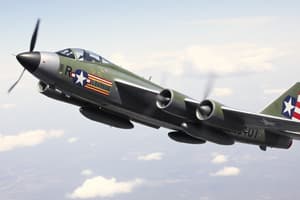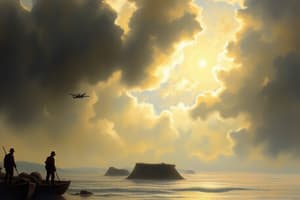Podcast
Questions and Answers
Why did the U.S. government implement rationing during World War II?
Why did the U.S. government implement rationing during World War II?
- To prevent shortages of essential goods for the military and war effort. (correct)
- To support increased production by private companies.
- To limit the amount of money Americans could spend on goods and services.
- To encourage Americans to consume more food and goods.
Which of the following events directly led to the United States entering World War II?
Which of the following events directly led to the United States entering World War II?
- The invasion of Poland by Germany.
- The attack on Pearl Harbor by Japan. (correct)
- The rise of Nazi Germany in Europe.
- The enactment of the Lend-Lease Act.
What was the primary reason for the internment of Japanese Americans during World War II?
What was the primary reason for the internment of Japanese Americans during World War II?
- A deliberate attempt to suppress Japanese American cultural identity.
- Fear and suspicion fueled by wartime propaganda and prejudice. (correct)
- Proof of widespread espionage and sabotage by Japanese Americans.
- Japanese American involvement in the attack on Pearl Harbor.
What did the policy of appeasement involve?
What did the policy of appeasement involve?
What role did women play in the American war effort during World War II?
What role did women play in the American war effort during World War II?
Which of the following best describes the impact of D-Day?
Which of the following best describes the impact of D-Day?
What was the main purpose of the Victory Gardens during World War II?
What was the main purpose of the Victory Gardens during World War II?
What was the primary role of the United States federal government in the economy during World War II?
What was the primary role of the United States federal government in the economy during World War II?
What was a key factor that contributed to the rise of World War II?
What was a key factor that contributed to the rise of World War II?
What significant event marked the US's entry into World War II?
What significant event marked the US's entry into World War II?
What was the main objective of the Manhattan Project?
What was the main objective of the Manhattan Project?
What was a key strategy employed by Allied forces in the Pacific Theater?
What was a key strategy employed by Allied forces in the Pacific Theater?
Which of these groups played a crucial role in breaking Japanese codes during World War II?
Which of these groups played a crucial role in breaking Japanese codes during World War II?
What marked the end of World War II in the Pacific Theater?
What marked the end of World War II in the Pacific Theater?
What was a significant impact of African American service during World War II?
What was a significant impact of African American service during World War II?
What is V-J Day, and when did it occur?
What is V-J Day, and when did it occur?
Flashcards
U.S. Foreign Policy (1935-1941)
U.S. Foreign Policy (1935-1941)
The U.S. transitioned from neutrality to actively supporting Allied nations during World War II.
Connection between WWI and WWII
Connection between WWI and WWII
The harsh Treaty of Versailles after World War I created resentment in Germany, contributing to the rise of Hitler and ultimately leading to the outbreak of World War II.
Similarities: Wilson's 14 Points and FDR's Atlantic Charter
Similarities: Wilson's 14 Points and FDR's Atlantic Charter
Both promoted self-determination, free trade, and the idea of a long-lasting peace after the war.
Manhattan Project
Manhattan Project
Signup and view all the flashcards
Why did Japan attack Pearl Harbor?
Why did Japan attack Pearl Harbor?
Signup and view all the flashcards
Impact of African American service in WWII
Impact of African American service in WWII
Signup and view all the flashcards
Who were the Tuskegee Airmen?
Who were the Tuskegee Airmen?
Signup and view all the flashcards
Who is Vernon Baker?
Who is Vernon Baker?
Signup and view all the flashcards
Appeasement
Appeasement
Signup and view all the flashcards
Start of World War II
Start of World War II
Signup and view all the flashcards
D-Day
D-Day
Signup and view all the flashcards
Japanese American Internment
Japanese American Internment
Signup and view all the flashcards
Lend-Lease Act
Lend-Lease Act
Signup and view all the flashcards
Rationing
Rationing
Signup and view all the flashcards
FDR's 'Infamy' Speech
FDR's 'Infamy' Speech
Signup and view all the flashcards
Victory Gardens
Victory Gardens
Signup and view all the flashcards
Study Notes
World War II Review
- German Invasion of Poland: Germany invaded Poland on September 1, 1939, triggering World War II.
- American Isolationism: Many Americans favored isolationism after World War I, aiming to avoid further foreign conflicts.
- Lend-Lease Act Support: The U.S. provided military aid to Allied nations (Britain, Soviet Union) before Pearl Harbor.
- Pearl Harbor Attack: The attack on Pearl Harbor on December 7, 1941, propelled the U.S. into World War II.
- FDR's War Declaration: Franklin D. Roosevelt's speech to Congress on December 8, 1941, declared December 7th "a date which will live in infamy" and spurred the war declaration.
- Bataan Death March: This brutal forced march of American and Filipino prisoners of war took place in the Philippines in 1942.
- Government Control of the Economy: The U.S. government regulated industries, rationing goods, and shifted production for war purposes.
- Rationing: A system limiting consumer goods to allocate resources for the war effort.
- American Contributions to the War Effort: Citizens rationed goods, purchased war bonds, recycled materials, and worked in war-related industries.
- Victory Gardens: Home gardens providing increased food production during the war.
- Japanese American Internment: Fear of espionage led to the forced relocation and internment of Japanese Americans after Pearl Harbor.
- Women and Minorities' Role: Women worked in factories and served in the military. Minorities served in segregated units and supported the war effort.
- Korematsu v. United States: The Supreme Court case upheld the constitutionality of Japanese American internment due to national security concerns.
- D-Day: Allied forces invaded Normandy, France on June 6, 1944, marking a significant turning point in the war.
- Appeasement: This policy of yielding to demands of aggressors contributed to the start of World War II.
- U.S. Foreign Policy Shift: Policy shifted from neutrality to aiding Allied nations between 1935 and 1941.
World War II Causes and Connections
- WWI and WWII Connection: The harsh Treaty of Versailles after WWI contributed to German resentment, fueling WWII.
- Wilson's 14 Points and FDR's Atlantic Charter: Both promoted ideals like self-determination, free trade, and lasting peace.
- Manhattan Project: A secret program to develop the atomic bomb.
- Japanese Attack on Pearl Harbor: Japan's goal was to cripple the U.S. Pacific Fleet and gain regional control.
- Impact of African American Service (WWII): Contributions by African American soldiers advanced the Civil Rights movement.
- Tuskegee Airmen: Well-known African American military pilots.
- Vernon Baker: An African American soldier honored with the Medal of Honor for bravery during WWII.
- Pacific Theater Commanders: General Douglas MacArthur and Admiral Chester Nimitz led troops and employed crucial strategies like island hopping.
Key Battles and Events
- Battle of Midway: A significant naval battle in the Pacific that was a decisive victory for the U.S. and turned the tide of the war.
- Flying Tigers: American volunteer pilots assisting China in their fight against Japan.
- Navajo Code Talkers: Navajo soldiers used their language for unbreakable military codes.
- Bombing Controversy: The use of atomic bombs to end the war was controversial due to its widespread destruction and civilian casualties.
- V-J Day: Victory over Japan Day, marking Japan's surrender on August 15, 1945.
- Holocaust Aftermath: The systematic genocide of millions during WWII highlighted the need for human rights and global efforts to prevent mass atrocities.
Studying That Suits You
Use AI to generate personalized quizzes and flashcards to suit your learning preferences.




